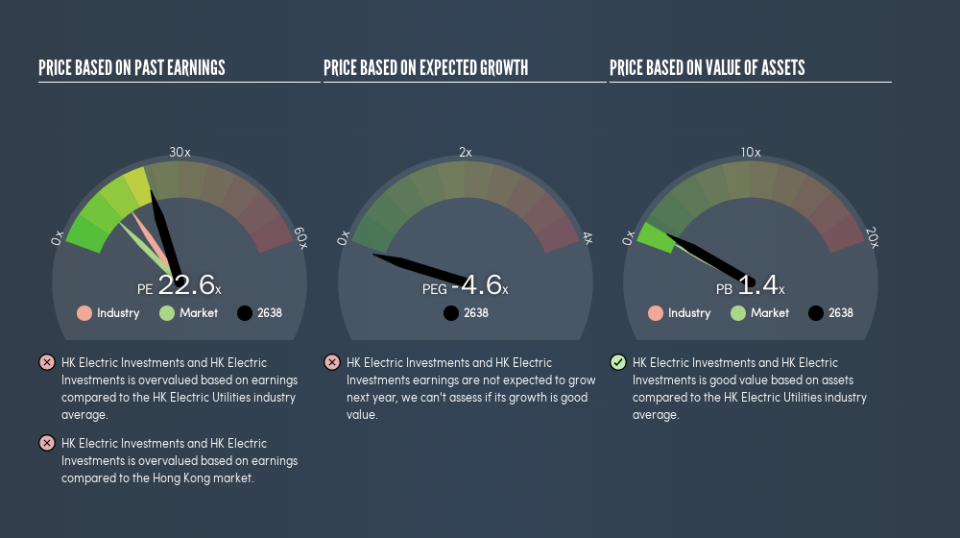Here's What HK Electric Investments and HK Electric Investments Limited's (HKG:2638) P/E Is Telling Us

Want to participate in a short research study? Help shape the future of investing tools and you could win a $250 gift card!
This article is written for those who want to get better at using price to earnings ratios (P/E ratios). To keep it practical, we'll show how HK Electric Investments and HK Electric Investments Limited's (HKG:2638) P/E ratio could help you assess the value on offer. Based on the last twelve months, HK Electric Investments and HK Electric Investments's P/E ratio is 22.59. That corresponds to an earnings yield of approximately 4.4%.
See our latest analysis for HK Electric Investments and HK Electric Investments
How Do You Calculate HK Electric Investments and HK Electric Investments's P/E Ratio?
The formula for P/E is:
Price to Earnings Ratio = Price per Share ÷ Earnings per Share (EPS)
Or for HK Electric Investments and HK Electric Investments:
P/E of 22.59 = HK$7.8 ÷ HK$0.35 (Based on the trailing twelve months to December 2018.)
Is A High P/E Ratio Good?
A higher P/E ratio implies that investors pay a higher price for the earning power of the business. That isn't necessarily good or bad, but a high P/E implies relatively high expectations of what a company can achieve in the future.
How Growth Rates Impact P/E Ratios
When earnings fall, the 'E' decreases, over time. That means unless the share price falls, the P/E will increase in a few years. Then, a higher P/E might scare off shareholders, pushing the share price down.
HK Electric Investments and HK Electric Investments saw earnings per share decrease by 8.7% last year. And EPS is down 10% a year, over the last 5 years. So it would be surprising to see a high P/E.
Does HK Electric Investments and HK Electric Investments Have A Relatively High Or Low P/E For Its Industry?
The P/E ratio essentially measures market expectations of a company. The image below shows that HK Electric Investments and HK Electric Investments has a higher P/E than the average (15.5) P/E for companies in the electric utilities industry.
HK Electric Investments and HK Electric Investments's P/E tells us that market participants think the company will perform better than its industry peers, going forward. The market is optimistic about the future, but that doesn't guarantee future growth. So investors should delve deeper. I like to check if company insiders have been buying or selling.
A Limitation: P/E Ratios Ignore Debt and Cash In The Bank
The 'Price' in P/E reflects the market capitalization of the company. Thus, the metric does not reflect cash or debt held by the company. In theory, a company can lower its future P/E ratio by using cash or debt to invest in growth.
Spending on growth might be good or bad a few years later, but the point is that the P/E ratio does not account for the option (or lack thereof).
Is Debt Impacting HK Electric Investments and HK Electric Investments's P/E?
HK Electric Investments and HK Electric Investments has net debt worth 61% of its market capitalization. This is a reasonably significant level of debt -- all else being equal you'd expect a much lower P/E than if it had net cash.
The Bottom Line On HK Electric Investments and HK Electric Investments's P/E Ratio
HK Electric Investments and HK Electric Investments has a P/E of 22.6. That's higher than the average in the HK market, which is 10.7. With significant debt and no EPS growth last year, shareholders are betting on an improvement in earnings from the company.
Investors have an opportunity when market expectations about a stock are wrong. If the reality for a company is better than it expects, you can make money by buying and holding for the long term. So this free visual report on analyst forecasts could hold the key to an excellent investment decision.
Of course, you might find a fantastic investment by looking at a few good candidates. So take a peek at this free list of companies with modest (or no) debt, trading on a P/E below 20.
We aim to bring you long-term focused research analysis driven by fundamental data. Note that our analysis may not factor in the latest price-sensitive company announcements or qualitative material.
If you spot an error that warrants correction, please contact the editor at editorial-team@simplywallst.com. This article by Simply Wall St is general in nature. It does not constitute a recommendation to buy or sell any stock, and does not take account of your objectives, or your financial situation. Simply Wall St has no position in the stocks mentioned. Thank you for reading.

